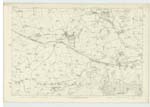OS1/1/41/58
| List of names as written | Various modes of spelling | Authorities for spelling | Situation | Description remarks |
|---|---|---|---|---|
| VITRIFIED FORT [Dunnideer] | Vitrified Fort Vitrified Fort Vitrified Fort |
Chalmers' Caledonia P. [Page] 383. Collections of the Shires Statistical Account |
044 | "By far the most interesting objects, however, which the parish holds out to Antiquarians, are the ruined fort and tower on the top of the hill of Dunnideer, the former being a fine specimen of what are called vitrified forts, the latter the remnant of a square tower or Castle built within the fort, and partly of fragments of it, covering from 13 to 14 square yards of ground, including the walls, 7 feet in thickness; only one wall, however, standing entire, and it being from 50 to 60 feet in height. As to the fort or enclosure, the subjoined remarks from Culloch's "Highlands and Islands of Scotland, give a sufficiently accurate description of it." "The hill of Dunnideer, having an elevation of about 600 feet from the irregular plain on which it stands, with a steep acclivity all around, has a flat oval summit, which is entirely occupied by the enclosure, so as to form a strong military position. Though much ruined, and consequently obscured, having apparently been used as a quarry for building a more modern Castle in the same spot (the square tower alluded to), it is not difficult to trace either the dimensions of the disposition of the original work. The form is a parallelogram of which one extremity is curved, so as to be nearly semicircular, and its longest side is about 58 yards, the shortest being about 24. At a certain stage down the hill are the well marked traces of a work, which once seems to have encircled the whole. It is a kind of fortification, well known to antiquaries as occurring frequently in the ancient British hill forts, and consists of a single ditch and wall, The materials in the vitrified wall are partly roasted without adhesion, and partly roasted without adhesion, and partly vitrified or glazed. It is easy to see that dark granite forms the vitrified or scorified substances. Wherever stones not capable of vitrification themselves have undergone anything like a similar change, it has been produced by alkali of the wood used in the process. The materials of the hill are chiefly grey granite, a fusible rock, but there are scattered, in the surrounding plain, blocks of a black variety which, from containing hornblende is very fusible." Statistical Account. |
Continued entries/extra info
[Page] 58Parish of Insch
Transcribers who have contributed to this page.
CorrieBuidhe- Moderator, Ron Dyce
Location information for this page.
Linked mapsheets.




